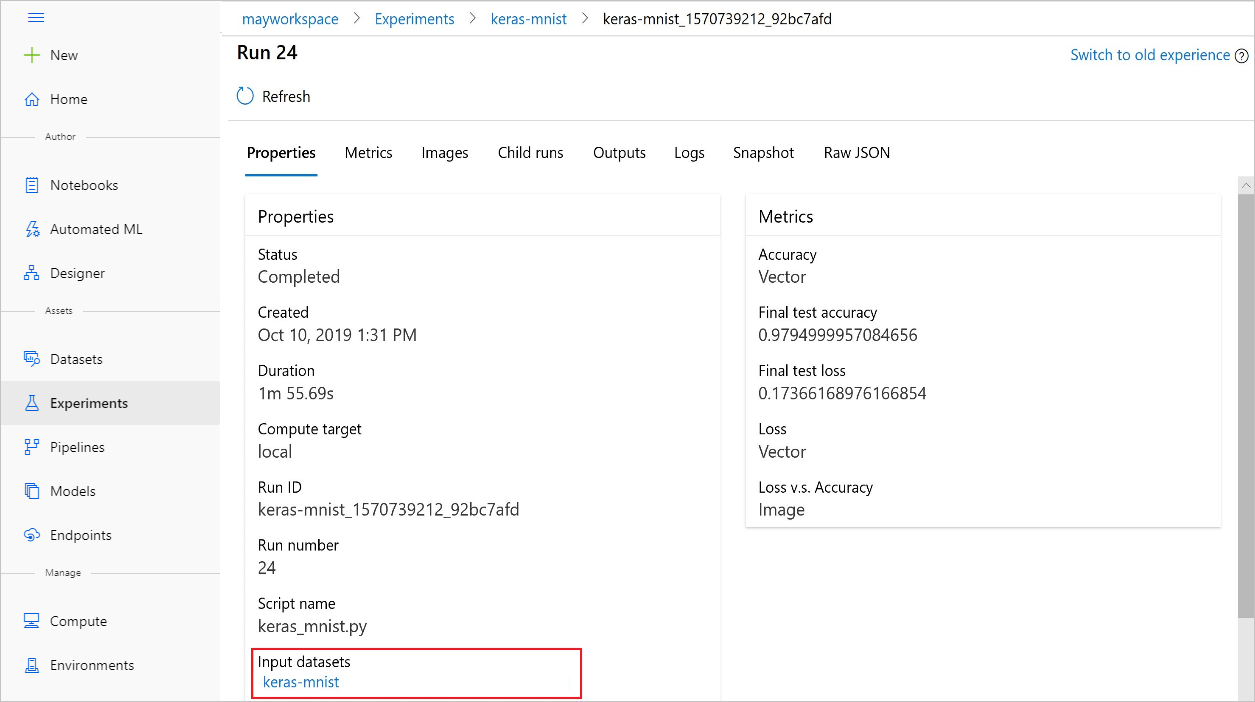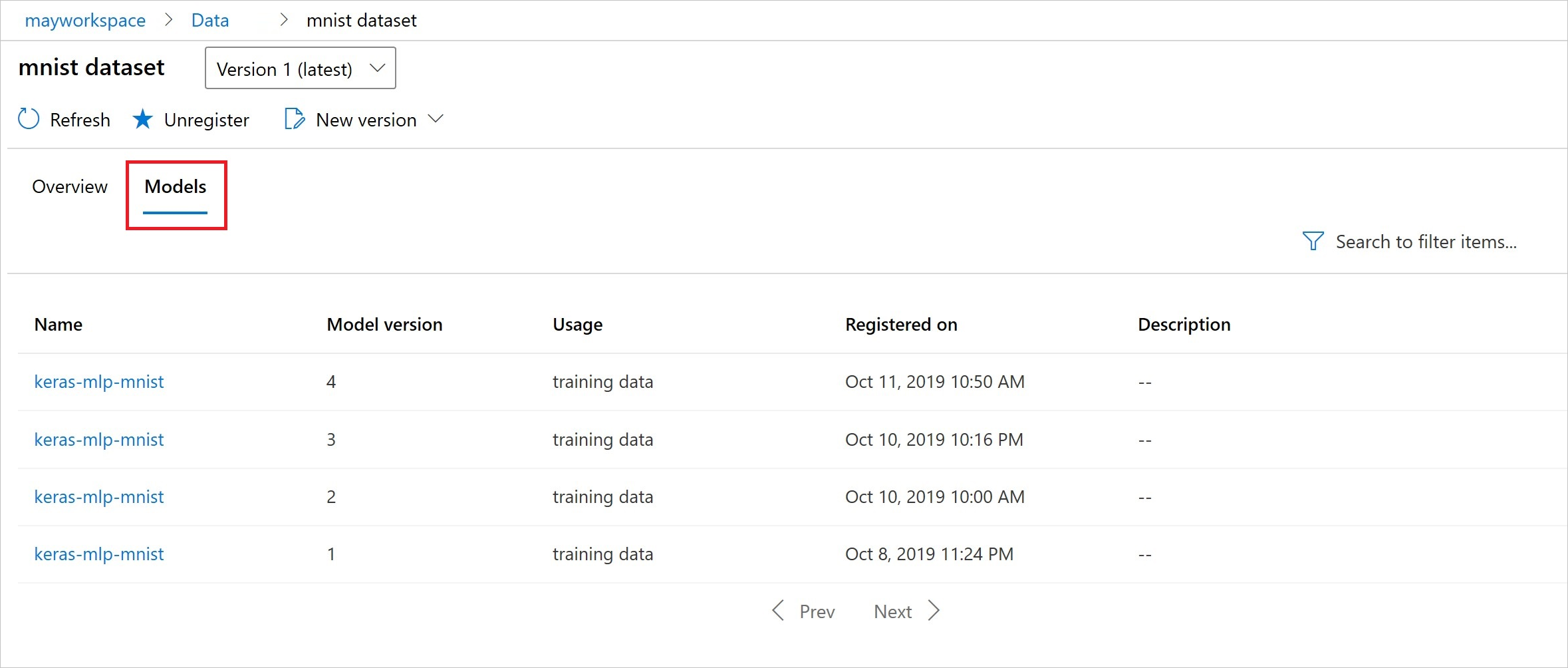对 Azure 机器学习数据集进行版本控制和跟踪
在本文中,你将了解如何对 Azure 机器学习数据集进行版本控制和跟踪,以实现可再现性。 数据集版本控制是为数据状态设置书签的一种方法,方便为将来的试验应用数据集的特定版本。
典型的版本控制方案:
- 当新数据可用于重新训练时
- 应用不同的数据准备或特征工程方法时
必备条件
对于本教程的内容,你需要:
安装了适用于 Python 的 Azure 机器学习 SDK。 此 SDK 包括 azureml-datasets 包。
Azure 机器学习工作区。 通过运行以下代码检索现有的工作区,或者创建新的工作区。
import azureml.core from azureml.core import Workspace ws = Workspace.from_config()
注册和检索数据集版本
通过注册数据集,可以对数据集进行版本控制,在试验之间以及与同事重复使用和共享数据集。 你可以使用相同的名称注册多个数据集,并按名称和版本号检索特定版本。
注册数据集版本
下面的代码通过将 create_new_version 参数设置为 True 来注册 titanic_ds 数据集的新版本。 如果没有向工作区注册现有 titanic_ds 数据集,则代码会创建一个名为 titanic_ds 的新数据集,并将其版本设置为 1。
titanic_ds = titanic_ds.register(workspace = workspace,
name = 'titanic_ds',
description = 'titanic training data',
create_new_version = True)
按名称检索数据集
默认情况下,Dataset 类中的 get_by_name() 方法返回已注册到工作区的数据集的最新版本。
下面的代码获取 titanic_ds 数据集的版本 1。
from azureml.core import Dataset
# Get a dataset by name and version number
titanic_ds = Dataset.get_by_name(workspace = workspace,
name = 'titanic_ds',
version = 1)
版本控制最佳做法
创建数据集版本时, 不会使用工作区创建额外的数据副本。 由于数据集是对存储服务中数据的引用,因此,你有单个由存储服务管理的事实来源。
重要
如果数据集引用的数据被覆盖或删除,则调用特定版本的数据集不会 还原更改。
从数据集加载数据时,始终会加载数据集引用的当前数据内容。 如果要确保每个数据集版本都是可再现的,建议你不要修改数据集版本引用的数据内容。 当新数据进入时,将新数据文件保存到单独的数据文件夹中,然后创建新的数据集版本以包含该新文件夹中的数据。
下图和示例代码展示了对数据文件夹进行构造的建议方式,以及创建引用那些文件夹的数据集版本的建议方式:

from azureml.core import Dataset
# get the default datastore of the workspace
datastore = workspace.get_default_datastore()
# create & register weather_ds version 1 pointing to all files in the folder of week 27
datastore_path1 = [(datastore, 'Weather/week 27')]
dataset1 = Dataset.File.from_files(path=datastore_path1)
dataset1.register(workspace = workspace,
name = 'weather_ds',
description = 'weather data in week 27',
create_new_version = True)
# create & register weather_ds version 2 pointing to all files in the folder of week 27 and 28
datastore_path2 = [(datastore, 'Weather/week 27'), (datastore, 'Weather/week 28')]
dataset2 = Dataset.File.from_files(path = datastore_path2)
dataset2.register(workspace = workspace,
name = 'weather_ds',
description = 'weather data in week 27, 28',
create_new_version = True)
对 ML 管道输出数据集进行版本控制
可以使用数据集作为每个 ML 管道步骤的输入和输出。 重新运行管道时,每个管道步骤的输出将注册为一个新的数据集版本。
ML 管道每次重新运行时都会将每个步骤的输出填充到一个新文件夹中。 此行为使得已进行版本控制的输出数据集可重现。 详细了解 管道中的数据集。
from azureml.core import Dataset
from azureml.pipeline.steps import PythonScriptStep
from azureml.pipeline.core import Pipeline, PipelineData
from azureml.core. runconfig import CondaDependencies, RunConfiguration
# get input dataset
input_ds = Dataset.get_by_name(workspace, 'weather_ds')
# register pipeline output as dataset
output_ds = PipelineData('prepared_weather_ds', datastore=datastore).as_dataset()
output_ds = output_ds.register(name='prepared_weather_ds', create_new_version=True)
conda = CondaDependencies.create(
pip_packages=['azureml-defaults', 'azureml-dataprep[fuse,pandas]'],
pin_sdk_version=False)
run_config = RunConfiguration()
run_config.environment.docker.enabled = True
run_config.environment.python.conda_dependencies = conda
# configure pipeline step to use dataset as the input and output
prep_step = PythonScriptStep(script_name="prepare.py",
inputs=[input_ds.as_named_input('weather_ds')],
outputs=[output_ds],
runconfig=run_config,
compute_target=compute_target,
source_directory=project_folder)
跟踪试验中的数据
Azure 机器学习在整个试验过程中跟踪数据作为输入和输出数据集。
以下是将数据作为输入数据集进行跟踪的场景。
提交试验作业时,通过
ScriptRunConfig对象的inputs或arguments参数传递DatasetConsumptionConfig对象。在脚本中调用 get_by_name() 或 get_by_id() 之类的方法时。 对于此场景,将数据集注册到工作区时分配给它的名称就是显示的名称。
以下是将数据作为输出数据集进行跟踪的场景。
提交试验作业时,通过
outputs或arguments参数传递OutputFileDatasetConfig对象。OutputFileDatasetConfig对象也可用于在管道步骤之间保留数据。 请参阅在 ML 管道步骤之间移动数据。在脚本中注册数据集。 对于此场景,将数据集注册到工作区时分配给它的名称就是显示的名称。 在以下示例中,
training_ds是将显示的名称。training_ds = unregistered_ds.register(workspace = workspace, name = 'training_ds', description = 'training data' )使用脚本中未注册的数据集提交子作业。 这会生成一个匿名保存数据集。
在试验作业中跟踪数据集
对于每个机器学习试验,可以通过试验 Job 对象轻松跟踪用作输入的数据集。
下面的代码使用 get_details() 方法跟踪试验运行时使用哪些输入数据集:
# get input datasets
inputs = run.get_details()['inputDatasets']
input_dataset = inputs[0]['dataset']
# list the files referenced by input_dataset
input_dataset.to_path()
还可以使用 Azure 机器学习工作室从试验中查找 input_datasets。
下图展示了在 Azure 机器学习工作室中从何处查找试验的输入数据集。 对于此示例,请转到“试验”窗格,并打开试验 keras-mnist 的特定运行的“属性”选项卡。

使用以下代码向数据集注册模型:
model = run.register_model(model_name='keras-mlp-mnist',
model_path=model_path,
datasets =[('training data',train_dataset)])
注册后,可以使用 Python 或转到工作室查看已注册到数据集中的模型列表。
以下视图来自“资产”下的“数据集”窗格。 选择数据集,然后选择“模型”选项卡以获取向数据集注册的模型的列表。

